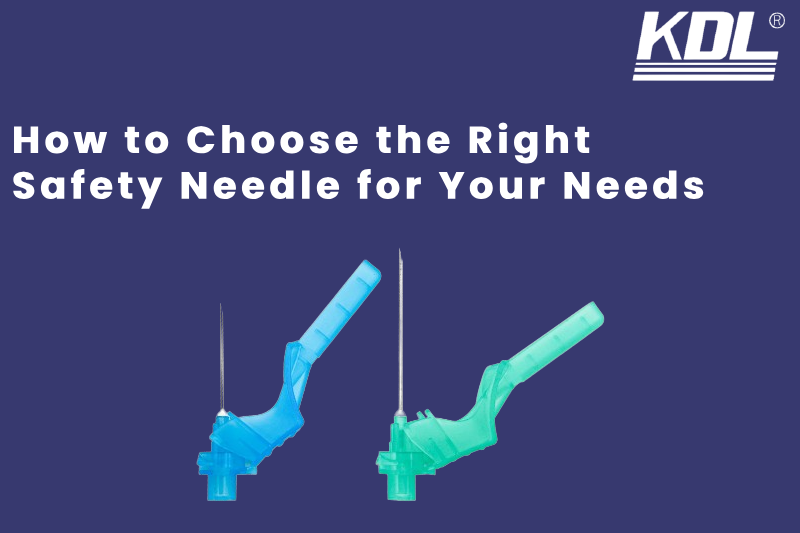
Ensuring the safety of patients and healthcare professionals is a top priority in any medical. This is why the use of safety needle has become increasingly important in the healthcare industry. Safety needles are designed to prevent needlestick injuries and the transmission of bloodborne diseases, making them a crucial tool in maintaining a safe and healthy working environment.
However, with numerous options available, it can be overwhelming to choose the right safety needle for your medical needs. In this guide, we’ll discuss the different types, sizes, and factors to consider when selecting a safety needle.
What are safety needle?
Safety needles are specially designed medical needles that help prevent accidental needle stick injuries. These injuries are a significant risk in healthcare and can lead to serious health issues, including the transmission of bloodborne diseases.
Types of Safety Needle
There are three main types of safety needles: retractable, non-retractable, and shielding.
- Retractable needles have a mechanism that allows the needle to retract into the syringe or device after use, preventing accidental needlesticks.
- Non-retractable needles do not have this feature and are disposed of in a sharps container after use.
- Shielding needles have a built-in shield that covers the needle after use, making it safe for disposal.
Key factors to consider when selecting a safety needle
Needle Design
The first factor to consider when choosing a safety needle is the design. Look for needles that have built-in safety features such as retractable needles or needle guards. These features help prevent accidental needlestick injuries and provide an extra layer of protection during use.
Needle Size
Another important factor to consider is the size of the needle. Choose a needle size that is appropriate for the procedure being performed. Using a needle that is too large can cause unnecessary discomfort for the patient, while using a needle that is too small may not be effective for drawing blood or administering medication.
Needle Material
The material of the needle is also crucial to consider. Opt for needles made from high-quality materials such as stainless steel to ensure durability and minimize the risk of breakage during use. Additionally, consider needles that are latex-free to reduce the risk of allergic reactions in patients and healthcare professionals.
Needle Compatibility
When choosing a safety needle, it is essential to ensure compatibility with the medical devices being use. Check that the needle is compatible with syringes, IV catheters, and other medical equipment to avoid any issues during procedures.
Needle Cost
While cost should not be the only factor to consider when choosing a safety needle, it is still an important consideration. Compare prices from different manufacturers and suppliers to find a needle that offers the best value for money without compromising on quality and safety.
Tips for Proper Handling and Disposal of Safety Needle
- Use the right technique: When using safety needles, it’s important to follow the proper technique to minimize the risk of needlestick injuries. Make sure to hold the needle at the correct angle and never recap a needle after use. Always dispose of used needles in a puncture-proof container immediately after use.
- Choose the right disposal container: When it comes to disposing of safety needles, using the right container is key. Look for a sharps container that is puncture-proof, leak-proof, and clearly labeled as a biohazard. Make sure to keep the container out of reach of children and pets.
- Don’t overfill the container: It’s important not to overfill your sharps container. Once it reaches the fill line, seal the container tightly and dispose of it according to your local regulations. Some areas may have specific guidelines for disposing of sharps containers, so be sure to check with your local health department.
- Know the regulations: Different states and countries may have specific regulations regarding the handling and disposal of safety needles. Make sure to familiarize yourself with the laws in your area to ensure compliance. This can help protect both you and the environment from potential harm.
Where to Purchase Quality Safety Needle
When it comes to purchasing safety needles, it’s important to buy from a reputable supplier. Look for medical supply companies like KDL. KDL stands out as a leading manufacturer and supplier of high-quality safety needles, designed to enhance patient safety and streamline medical procedures. KDL ensures that each safety needle is engineered for reliability and ease of use, minimizing the risk of needlestick injuries.
Conclusion
In summary, choosing the right safety needle is essential for safe and effective medical procedures. Consider the type of procedure, frequency of use, size and gauge, and specific safety features when selecting a safety needle. With proper use and disposal, safety needles can help protect healthcare workers and patients from needlestick injuries and the spread of blood-borne diseases.
 +86-791-8686-1216
+86-791-8686-1216 

